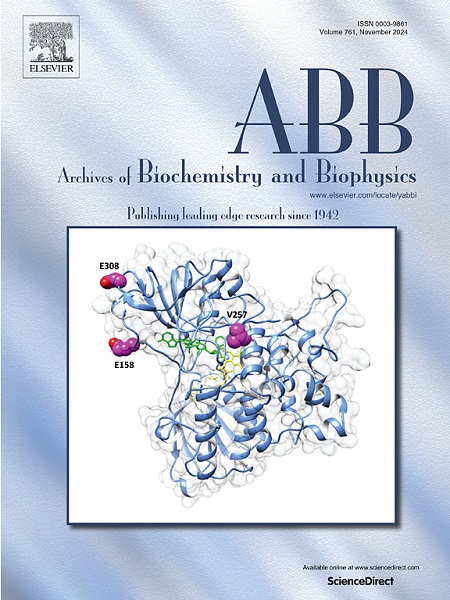Structural and biophysical characterization of the cytoplasmic domains of HprS kinase and its interactions with the cognate regulator HprR
IF 3.8
3区 生物学
Q2 BIOCHEMISTRY & MOLECULAR BIOLOGY
引用次数: 0
Abstract
The HprSR constitutes the bacterial two-component regulatory system engaged by Escherichia coli to reduce the damaging effects of reactive chlorine and oxygen species present in its cytosol. Hypochlorous acid (HOCl) has been shown to be the molecule capable of activating of the HprSR system. HOCl is produced upon pathogen invasion by phagocytic cells of the human innate immune system, particularly neutrophils, to take advantage of its powerful antimicrobial attributes. Therefore, comprehensive studies concerning bacterial sensing and regulatory HprSR system are indispensable in understanding and effectively eliminating pathogens. Here we present the first crystal structure, solved at 1.7 Å resolution, of the HprS cytoplasmic domains arranged as a homodimer. In both protomers, the catalytic ATP-binding domain contains a non-hydrolysable ATP analog coordinated by a magnesium ion. This structure allowed us to provide a detailed characterization of kinase-substrate interaction. Furthermore, the structural data are supported by biophysical studies of kinase interaction with cognate response regulator HprR and substrate ATP. The kinase activity is also assessed in the presence or absence of HprR.

HprS激酶细胞质结构域的结构和生物物理特性及其与同源调节因子HprR的相互作用。
HprSR构成了大肠杆菌参与的细菌双组分调控系统,以减少存在于其细胞质中的活性氯和氧的破坏性影响。次氯酸(HOCl)已被证明是能够激活HprSR系统的分子。HOCl是在病原体入侵时由人类先天免疫系统的吞噬细胞,特别是中性粒细胞产生的,以利用其强大的抗菌特性。因此,全面研究细菌感知和调控HprSR系统是认识和有效消灭病原体的必要条件。在这里,我们提出了第一个晶体结构,以1.7 Å分辨率解决,HprS细胞质结构域排列为同型二聚体。在这两种原聚体中,催化ATP结合结构域包含由镁离子配位的不可水解ATP类似物。这种结构使我们能够提供激酶-底物相互作用的详细表征。此外,激酶与同源反应调节因子HprR和底物ATP相互作用的生物物理研究也支持了结构数据。激酶活性也被评估在存在或不存在HprR。
本文章由计算机程序翻译,如有差异,请以英文原文为准。
求助全文
约1分钟内获得全文
求助全文
来源期刊

Archives of biochemistry and biophysics
生物-生化与分子生物学
CiteScore
7.40
自引率
0.00%
发文量
245
审稿时长
26 days
期刊介绍:
Archives of Biochemistry and Biophysics publishes quality original articles and reviews in the developing areas of biochemistry and biophysics.
Research Areas Include:
• Enzyme and protein structure, function, regulation. Folding, turnover, and post-translational processing
• Biological oxidations, free radical reactions, redox signaling, oxygenases, P450 reactions
• Signal transduction, receptors, membrane transport, intracellular signals. Cellular and integrated metabolism.
 求助内容:
求助内容: 应助结果提醒方式:
应助结果提醒方式:


